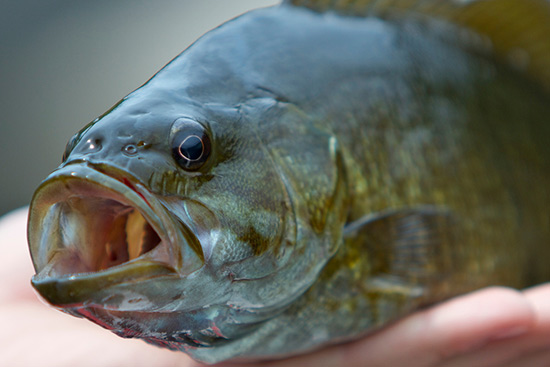Bay Foundation cites nutrient pollution as big threat to smallmouth bass
Excess nutrients are making the sport fish more susceptible to infections and death.
Over the past decade, smallmouth bass in five Chesapeake Bay tributaries have suffered from fish kills and perplexing illnesses—and nutrient pollution could be to blame.
According to a new report from the Chesapeake Bay Foundation (CBF), excess nitrogen and phosphorous in our rivers and streams could be behind two of the leading problems affecting smallmouth bass: first, the rapid growth of fish parasites and their hosts, and second, the expansion of large algae blooms that can lead to low-oxygen conditions and spikes in pH. When paired with rising water temperatures and ever more prevalent chemical contaminants, nutrient pollution seems to have created a “perfect storm” of factors that are making smallmouth bass more susceptible to infections and death.

Image courtesy Mr. OutdoorGuy/Flickr
In a media call, CBF President Will Baker called the smallmouth bass “the canary in the coal mine for the Bay’s rivers.” Because the fish is sensitive to pollution, problems within the population could indicate problems within the Bay.
Smallmouth bass in the Susquehanna, Monocacy, Shenandoah, Cowpasture and South Branch of the Potomac rivers have seen a string of recent health problems, from open sores and wart-like growths to abnormal sexual development. In the Susquehanna, smallmouth bass populations have plummeted so far that Pennsylvania has made it illegal to catch the fish during spawning season.
“Our fish are sick, our anglers are mad and my board and I—protectors of our [smallmouth bass] fishery—are frustrated,” said John Arway, executive director of the Pennsylvania Fish and Boat Commission. “Our bass, and our grandchildren who will fish for them, are depending on us to fix the problem.”

Image courtesy CBF
While specific causes of smallmouth bass fish kills and illnesses remain unclear, CBF has called on state and local governments to accelerate their pollution-reduction efforts in hopes of improving water quality and saving the driving force behind a $630 million recreational fishing industry. The non-profit has also called on the federal government to designate a 98-mile stretch of the Susquehanna as impaired, which would commit Pennsylvania to reversing the river’s decline.
“This is the moment in time to save fishing in our streams and rivers, as well as the jobs and quality of life that are connected to it,” Baker said.
Read more about Angling for Healthier Rivers: The Link Between Smallmouth Bass Mortality and Disease and the Need to Reduce Water Pollution in Chesapeake Bay Tributaries.

Comments
There are no comments.
Thank you!
Your comment has been received. Before it can be published, the comment will be reviewed by our team to ensure it adheres with our rules of engagement.
Back to recent stories